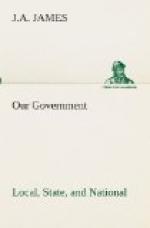The First Ten Amendments.—A large number of propositions, therefore, were submitted to the first Congress by the States. Seventeen of these were selected by the House of Representatives, and proposed as amendments to the Constitution. Twelve of these were acceptable to the Senate also, and ten were ratified by the required three-fourths of the State legislatures. We call them the first ten amendments to the Constitution. If we read these amendments, we shall find that really they are a bill of rights, for the preservation or protection of rights of the people is expressed in all.[39]
[Footnote 39: See Appendix A.]
CHAPTER XIII.
THE EXECUTIVE DEPARTMENT.
The President and His Election.—We have seen that the one great weakness of the government under the confederation was that there existed no adequate executive. After much discussion in the convention, the fear of a despot at the head of affairs gave place to the desire to secure executive energy and responsibility. To-day the President is the most notable personage among all our officials. Mr. Bryce calls the Presidential office the greatest office in the world unless we except the papacy. In the Executive Department the President’s power is practically absolute. He may appoint and remove, either directly or indirectly, all officials of the department, and they are finally responsible to him in the performance of their duties. His control of international relations and his influence on legislation are, as we shall see, extensive.
Length of Term.—Article II, Section 1, Clause 1. The executive power shall be vested in a President of the United States of America. He shall hold his office during the term of four years, and, together with the Vice-President, chosen for the same term, be elected as follows:—
Method of Election.—How shall the President be chosen? This problem is said to have taken one-seventh of the entire time of the convention. While there were those who believed that election by the people would be wise, still this sentiment was not general. It was thought that a choice in this way would cause great “tumult and disorder.” Besides, it was urged that the people would not be sufficiently acquainted with the men who have the necessary qualifications for such high office. For a special investigation of this sort, they agreed that it would be best to select a small number of persons who would be most likely to possess the required information and discernment. The appointment of these independent electors was provided for as follows:—
Appointment of Electors.—Section 1, Clause 2. Each State shall appoint, in such manner as the legislature thereof may direct, a number of electors equal to the whole number of senators and representatives to which the State may be entitled in the Congress; but no senator or representative or person holding an office of trust or profit under the United States, shall be appointed an elector.




